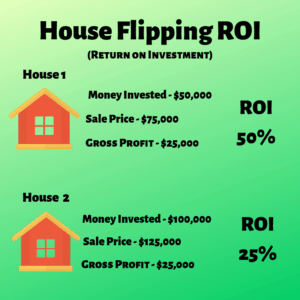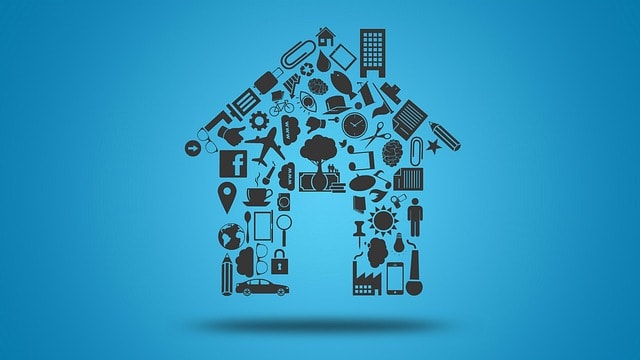Flipping houses average profit can be a hard number to pin down because there are so many variables that can affect house-flipping profits.
Because of these different variables and factors, house-flipping profits can range from $0 to over $100,000.
Flipping Houses Average Profit Breakdown
As with anything though there are averages you can look at to give you a general idea of how much you can make flipping houses.
According to Attom Data Solutions, the average gross profit from flipping houses in the first quarter of 2018 nationwide was $69,500.
Before you get too excited about this number though there are a few things to keep in mind. The first being that this number represents an average as it’s possible to make much less or even nothing when flipping a house. The second and perhaps most important thing to pay attention to is the word gross that comes before the word profit.
The wording gross profit is important because it doesn’t indicate what the house flipper actually made in profit but instead represents the difference in price from when they sold it to when they bought it.
The problem is this gross profit number doesn’t account for many of the costs associated with the flip itself such as the cost to repair and remodel the home, the costs of buying and selling the property, and holding costs such as taxes, insurance, interest, and utilities.
So while $69,500 might seem like a very enticing number, remember you must subtract all the costs associated with the flip before you can see what the actual or net profit of the flip was.
Speaking as a house flipper in the midwest, after many flips our average net profit tends to be around $30,000. While this is still a nice flipping profit, it’s certainly a lot different than $69,500.
How Location Affects Flipping Houses Average Profit?
It’s important to keep in mind that this $30,000 average net profit is based on flipping houses in the midwest.
As location can have a big impact on the amount of profit you can expect from flipping houses.
While $30,000 might be a good average profit for the midwest you may make more or less depending on the area of the country you’re located in. Don’t forget though that things tend to be relative especially when it comes to house flipping profits.
This brings us to our next point which is a term called ROI.
When considering flipping houses average profit it’s important to consider the percentage of return on the money invested or ROI (return on investment).
For example, consider these two house flipping scenarios where each house flipper made the same amount of gross profit but one flipper invested far more capital to receive the same return.
In the first quarter of 2018, the average return on investment for a house flip was 47.8%. As you can see from the example above it’s not just how much profit a house flip made but also how much money was invested into the flip.
For example, while a house flipper that made $50,000 seems better than a flipper that made $25,000 you have to know what their ROI percentage was to get a true picture of the successfulness of each flip.
Factors that Can Affect House Flipping Average Profits
As mentioned above there are many different factors and circumstances that can affect average profits when it comes to house flipping. Below are some of the biggest factors that can affect house-flipping profits.
Location
One of the biggest factors that can affect flipping house profits or real estate, in general, is location. After all, there’s even a common phrase in real estate which is “location, location, location” that stresses just how important location can be to real estate.
Cost of Property
Another common phrase in the house flipping community is “you make your money when you buy”. This simply means that the potential profit you can make on any given flip comes down to how much you paid for the property, not how much you sold it for.
If the after repaired value of the home you are flipping is $100,000 and the fixed costs of remodeling the home is $25,000, then there is really only one number you can affect with any kind of impact, which is the purchase price you paid for the home.
In the above example if you purchased the home for $50,000 then you stand to make $25,000 in profit. If however, you purchased the home for $40,000 you could make $35,000 on the same flip. That’s a $10,000 jump in profit just by buying the home cheaper.
Rehab Costs
One of the quickest ways to turn a flip into a flop is a runaway budget or runaway rehab costs. When flipping houses you have to think of profit as something that must be protected.
While it’s important in house flipping to turn out a quality product that looks good and attracts buyers, always be on the lookout for cost savings. As any dollar you save when rehabbing the property is an extra dollar of profit when you sell the home.
Supply and Demand
When house flipping average profits can be greatly impacted by current market conditions and what’s happening in the market when you go to buy or sell your house flip.
When it comes to real estate there are two main types of markets that can exist including a buyer’s market or a seller’s market. In a buyer’s market, there are more sellers in the market than buyer’s which tends to drive the prices of homes down. Whereas, in a seller’s market there are more buyers than seller’s which tends to drive home prices up.
Keep in mind because of the typically short time frame of house flipping you will more than likely be in the same type of market when you buy the home as when you sell. Because of this duality, things have a way of evening themselves out.
For example, in a buyer’s market, you may be able to purchase the property at a much cheaper price but you will then be limited on how much you can sell the flip for. On the other hand in a seller’s market, you might have to pay a premium to purchase the property but when it comes time to sell your flip you can demand top dollar.
As you can see there are pros and cons to each type of real estate market when flipping houses.
As a house flipper, I love to sell flips in a seller’s market but it can be a double-edged sword. Because in a seller’s market it’s very difficult to find a property that makes sense due to inflated home prices.
Sales and Marketing
The final factor that can affect flipping house’s average profit is the sales and marketing of the flip.
As both a real estate agent and a house flipper I know that there is always a range that any home can sell for on any given day. With the range being smaller at lower home prices and larger at higher home prices.
While the market and banks will ultimately put a cap on what a home can sell for, as a flipper you want to make sure that your selling on the higher side of that range. To do this when it comes time to sell your flip you need to pay close attention to the sales and marketing to ensure top dollar.
Items that ensure the best profit margin for a flip when it comes to sales and marketing include maximum home exposure to buyer’s and the market, making sure the home is warm and inviting with ample light, excellent marketing photos that put the property in the best possible light, playing up the home’s advantages and downplaying the homes disadvantages, and offering bonuses and enticements to sell the home quickly.
Want to learn more about house flipping profits and how to make a living flipping houses? If so check out our article on “How to Flip Houses for a Living“.
Recent Posts
How much does a push lawn mower cost? This is a question that many people have when they're looking for a new lawn mower. The good news, however, is that push lawn mowers are one of the most...
Are you looking for a cheap lawn mower? If so, you've come to the right place! Because in this blog post, we've highlighted the 10 cheapest lawn mowers on the market today. Plus, we provide...



